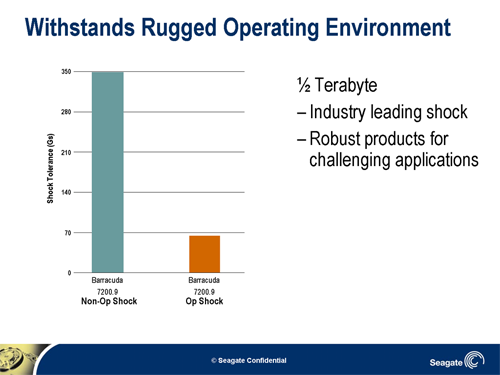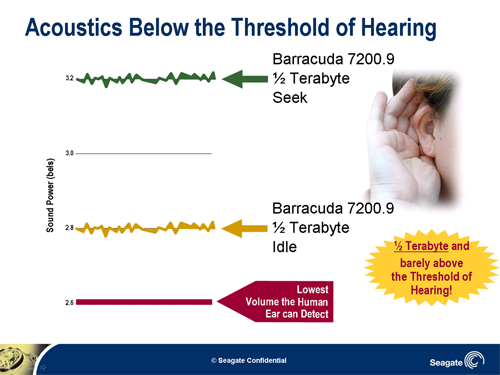Introducing Seagate's 7200.9: The New Generation
by Purav Sanghani on October 10, 2005 9:00 AM EST- Posted in
- Storage
The 7200.9 Series
On the outside, the 7200.9 drives look identical to the 7200.7 and 7200.8 series of desktop drives. On the inside, the 7200.8 line was the first to incorporate the highest density platters to date in their 400GB version drive at 133GB per platter. This puts Seagate ahead of Hitachi who released their 500GB DeskStar quite some time ago. The new 7200.9 line has incorporated a higher density 160GB platter into a few of its drives. The following screenshot shows the manufacturer's specifications for each 7200.9 drive according to capacity size.
The 160GB platter has only gone into the 80GB drive, which uses a single side and single head, and the 160GB drive, which uses both sides of the platter with 2 heads. The 400GB model still uses its original three 133GB platter design that was implemented in the 7200.8, while the new 500GB drive uses four 125GB platters. Why not just use the 160GB platters for the 500GB drive? Doing the math, 3x160GB would bring us to 480GB, which is 20GB short of the 500GB mark, and 4x160GB comes out to 640GB, which cannot be marketed at 500GB without a 140GB waste in total capacity. It makes the most sense to use 4x125GB platters to bring us to a perfect 500GB total capacity. (Note that the drive's total capacity will be slightly lower in Windows, as 1GB is 1,073,741,824 bytes for Windows, but only 1,000,000,000 bytes in hard drive manufacturer specs.)
All of the SATA 2.5 Trimmings
A few months ago, we cleared up some confusion regarding the SATA naming conventions and what they mean. The confusion was with the SATA II name being used in unison with the 3.0Gb/sec transfer rate. SATA II was actually the name of the SATA standards organization, which decides the specifications for each SATA version. (They've since changed names to SATA-IO.) At the time, many thought that the 3.0GB/sec came standard in all drives labeled as SATA II. In fact, transfer rate along with other options such as hot plug, hot swap, and NCQ are options that drive manufacturers can implement in their products if they choose. You can even get most of the "SATA II" features in "SATA I" drives.
Seagate states that it has incorporated all of the features that SATA has to offer in the 7200.9 series including the following:
In 2004, 20% of hard disk drives shipped were SATA based - about 41 million, according to Seagate Market Research. It is estimated that this year, the percentage will increase to 80% of shipped drives being SATA based, 40% of which will be Seagate drives. Meanwhile, PATA is being phased out and nearly all production will cease by the end of 2006.
Other Characteristics
Seagate reports that all of the drives in the 7200.9 line will feature an operating shock tolerance of about 63Gs and a non-operating shock of 350Gs, making them extremely rugged. Almost all but Hitachi's 7K500 drive can handle this much non-operating shock, but shock tolerance during normal operation is not as forgiving, with many drives only allowing about 55Gs. Not that we would recommend dropping your drives or computer, but accidents happen...
Seagate is also reporting a lower sound rating between 2.5-2.8 bels while the drives are idle, and about 2.8-3.2 bels while the drives are seeking for data. According to Seagate, the lowest amount of sound audible by human ears is about 2.6 bels, so the idle noise output is borderline inaudible to our ears. Combine this with the hum of case and heat sink fans, and the hard drive is basically silent.
On the outside, the 7200.9 drives look identical to the 7200.7 and 7200.8 series of desktop drives. On the inside, the 7200.8 line was the first to incorporate the highest density platters to date in their 400GB version drive at 133GB per platter. This puts Seagate ahead of Hitachi who released their 500GB DeskStar quite some time ago. The new 7200.9 line has incorporated a higher density 160GB platter into a few of its drives. The following screenshot shows the manufacturer's specifications for each 7200.9 drive according to capacity size.
The 160GB platter has only gone into the 80GB drive, which uses a single side and single head, and the 160GB drive, which uses both sides of the platter with 2 heads. The 400GB model still uses its original three 133GB platter design that was implemented in the 7200.8, while the new 500GB drive uses four 125GB platters. Why not just use the 160GB platters for the 500GB drive? Doing the math, 3x160GB would bring us to 480GB, which is 20GB short of the 500GB mark, and 4x160GB comes out to 640GB, which cannot be marketed at 500GB without a 140GB waste in total capacity. It makes the most sense to use 4x125GB platters to bring us to a perfect 500GB total capacity. (Note that the drive's total capacity will be slightly lower in Windows, as 1GB is 1,073,741,824 bytes for Windows, but only 1,000,000,000 bytes in hard drive manufacturer specs.)
All of the SATA 2.5 Trimmings
A few months ago, we cleared up some confusion regarding the SATA naming conventions and what they mean. The confusion was with the SATA II name being used in unison with the 3.0Gb/sec transfer rate. SATA II was actually the name of the SATA standards organization, which decides the specifications for each SATA version. (They've since changed names to SATA-IO.) At the time, many thought that the 3.0GB/sec came standard in all drives labeled as SATA II. In fact, transfer rate along with other options such as hot plug, hot swap, and NCQ are options that drive manufacturers can implement in their products if they choose. You can even get most of the "SATA II" features in "SATA I" drives.
Seagate states that it has incorporated all of the features that SATA has to offer in the 7200.9 series including the following:
- Hot Plug
- Hot Swap
- ClickConnect
- Native Command Queuing (NCQ)
- Staggered Spin-Up
- 3G (3.0Gb/sec, backwards compatible with 1.5Gb/sec hardware) maximum transfer rates
In 2004, 20% of hard disk drives shipped were SATA based - about 41 million, according to Seagate Market Research. It is estimated that this year, the percentage will increase to 80% of shipped drives being SATA based, 40% of which will be Seagate drives. Meanwhile, PATA is being phased out and nearly all production will cease by the end of 2006.
Other Characteristics
Seagate reports that all of the drives in the 7200.9 line will feature an operating shock tolerance of about 63Gs and a non-operating shock of 350Gs, making them extremely rugged. Almost all but Hitachi's 7K500 drive can handle this much non-operating shock, but shock tolerance during normal operation is not as forgiving, with many drives only allowing about 55Gs. Not that we would recommend dropping your drives or computer, but accidents happen...
Seagate is also reporting a lower sound rating between 2.5-2.8 bels while the drives are idle, and about 2.8-3.2 bels while the drives are seeking for data. According to Seagate, the lowest amount of sound audible by human ears is about 2.6 bels, so the idle noise output is borderline inaudible to our ears. Combine this with the hum of case and heat sink fans, and the hard drive is basically silent.
In the next few weeks we will be looking at the performance of the 500GB 16MB SATA model of the 7200.9. We'll put it through our usual synthetic, simulated, and real world tests, and we'll compare it not only to the 400GB 7200.8, but also to some older drives like the 120GB 7200.7 as well as Maxtor's and Hitachi's higher capacity drives.













72 Comments
View All Comments
ElFenix - Monday, October 10, 2005 - link
"in their 400GB version drive at 133GB per square inch. "unless platers are 1/2 of a sq. inch per side, which i doubt, this statement is wrong.
i'm still having trouble understanding why this isn't in news, rather than a front page article.
JarredWalton - Monday, October 10, 2005 - link
It's not a review, it's an announcement of a new product which we feel many people will find interesting. If I were about ready to spend $100 on a 250GB drive, I'd sure like to know that Seagate has just released their 7200.9 series. This is an introduction to the technology, and an explanation about what has changed. The 16 MB cache models are certainly noteworthy, and all indicators are that the new drives will at worst match the old 7200.7/.8 Seagate models.Price is the only thing I would worry about. If the 250GB 7200.9 costs $150 vs. $100, I probably wouldn't bother. Right now, http://labs.anandtech.com/search.php?q=seagate+160...">prices on the 160GB models are in favor of the new 7200.9. The remaining http://labs.anandtech.com/search.php?q=7200.9">7200.9 drives in our RTPE may or may not be worth consideration. $380 for the 500GB is more than I'm willing to pay for a single drive.
cryptonomicon - Monday, October 10, 2005 - link
argh forget it. i guess i just want to see the reviews perfect for the sake of keeping anandtech the best it can be, so even though a typo doesn't affect the real content of an article (but it still devalues it)joex444 - Tuesday, October 11, 2005 - link
This is true. If this was my first visit and I hadn't read articles here before, the typos really just make the author and the site appear ignorant. People in general, atleast ones that know the correct way, tend to stop reading things if they are written improperly; they just look like a child wrote it.SpaceRanger - Monday, October 10, 2005 - link
I wouldn't call it a review. Read more like a commercial for Seagate.Xenoterranos - Monday, October 10, 2005 - link
You know what. Anandtech has never posted any news that has ever been considered "out of touch". They're reviews are as unbiased as reviews can be without being written by cold, unfeeling machines. If Anadtech decided that these segate drives were good enough to give a free comercial too, then thats the best kind of marketing isn't it? I remember back in the day when a 40gig was huge, I called a local dealer and asked them for the cheapest 40gig they had. The guy said "We'll, that would be a Ninja [something], but I wouldn't recommened that unless you want to come back tomorrow and call in the warranty." Ok, that was a but off topic. Long live the Queen, free tibet, and all that jazz.PuravSanghani - Monday, October 10, 2005 - link
I would actually call this an article detailing Seagate's official introduction of the 7200.9 line. As far as purchasing these drives go, they have shipped in the last few weeks and are in stock at many places already.As we mentioned in the article, we will be providing benchmarks of the 500GB version of the 7200.9 within the next few weeks.
Thanks,
Purav Sanghani
ATWindsor - Monday, October 10, 2005 - link
"The lowest amount of sound audible by human ears is 26 decibels, so the idle noise output is borderline inaudible to our ears"This seems to be taken from the info Seagate has published, unfotantly it is not correct. The db(p)-scale has it reference at the human hearing threshold. In other words, the human hearing threshold is 0 db. (although there obivously are individual differences, and background noise rarly is under 15 db).
PuravSanghani - Monday, October 10, 2005 - link
Looking at the charts, we meant to say 2.5, 2.6, 2.8, and 3.2 bels. The numbers have been fixed to match the slides from Seagate.ATWindsor - Monday, October 10, 2005 - link
I see you also added "according to seagate" which is good.